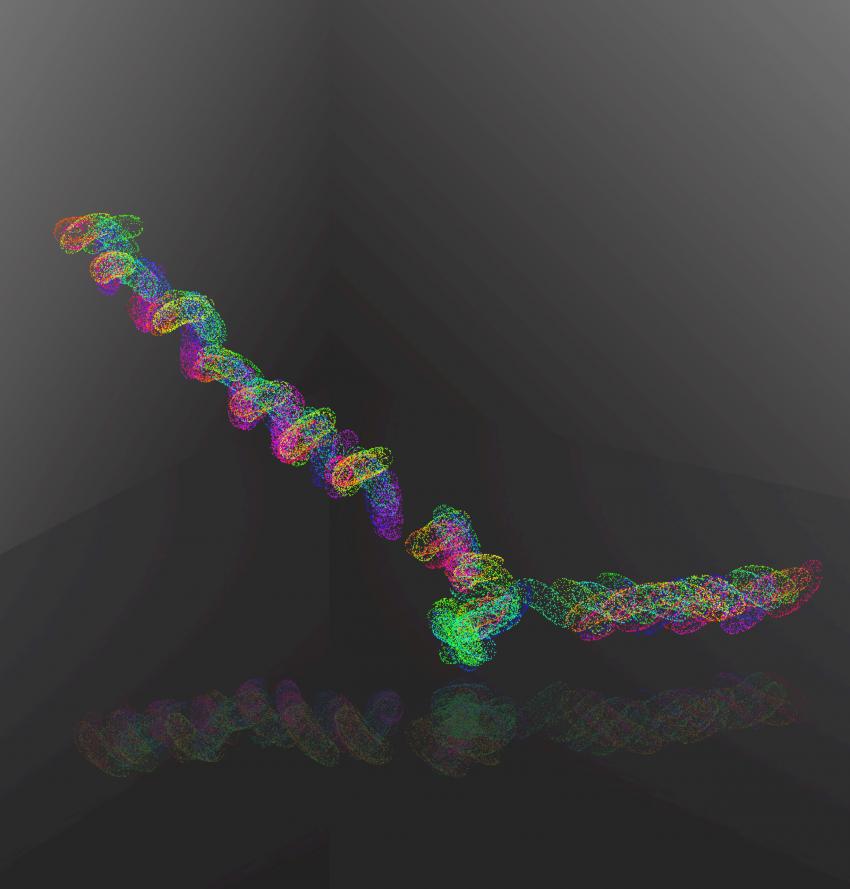PNAS:细胞体的螺旋运动才是细菌的动力来源

细胞体的螺旋运动才是真正的动力来源
许多细菌依靠鞭毛、螺旋状附属物一推一拉产生的推力游动,原理有些类似螺旋桨。长久以来,学界都认为是鞭毛完成了所有的游动,而细胞体其他部分只是负责“掌舵”。但布朗大学(Brown University)研究人员的最新的研究成果表明,至少对一种细菌来说,细胞体的螺旋运动才是真正的动力来源,它帮助微生物四处游弋。
布朗大学工程院教授肯尼·布鲁尔(Kenny Breuer)表示:“据我们所知,这是人类第一次定量分析细胞体如何参与游动过程。人们过去认为,细胞体没起到什么作用,表面上它在拉着细菌前进。但这次,我们得出了不同的结论。”相关研究成果发表在7月21日的期刊《美国科学院院报(Proceedings of the National Academy of sciences)》中。
研究如此微小的生物究竟怎么游动,确实需要一些复杂的成像技术。传统的显微镜在这里帮不上多大忙,所以在本研究中,科学家使用了一种特殊方式,得以实时、近距离追踪细菌细胞的运动。这里用到了一台可追踪型显微镜,这个设备同样由布朗大学学者制造。它装配有观察细菌的可移动平台,可锁定指定细菌,并根据细菌活动移动平台,确保细菌位于显微镜视野正中。
研究人员使用这种追踪技术研究了一种名为新月柄杆菌(Caulobacter crescentus)的芸豆状细菌。这种细菌只有单一鞭毛,并能以两种不同的方式运动——鞭毛可从尾部向前推进,也可从前方向后推进。
布鲁尔提到:“我们简直不敢相信一开始观察到的结果——它向前游要比向后游快。我们不敢轻易下结论,因为根据物理学原理,无论向前向后,它应该游动得一样快。我们更加好奇,因此进行了更多深入研究。”
通过进一步分析,研究人员注意到该细菌的躯体部分,在游动过程中沿着不稳定的、螺旋式的轨迹行进,看起来就像它在沿着一个看不见螺旋管道运动。这种运动在向后倒车时要比向前行进微弱。通过采用基于“阻力理论(resistive force theory)”的数学模型,研究人员证实不同躯体运动产生的推力导致了细菌向前后游动速度的差异。
原文摘要:
Helical motion of the cell body enhances Caulobacter crescentus motility
Bin Liu, Marco Gulino, Michael Morse, Jay X. Tang, Thomas R. Powers and Kenneth S. Breuer
We resolve the 3D trajectory and the orientation of individual cells for extended times, using a digital tracking technique combined with 3D reconstructions. We have used this technique to study the motility of the uniflagellated bacterium Caulobacter crescentus and have found that each cell displays two distinct modes of motility, depending on the sense of rotation of the flagellar motor. In the forward mode, when the flagellum pushes the cell, the cell body is tilted with respect to the direction of motion, and it precesses, tracing out a helical trajectory. In the reverse mode, when the flagellum pulls the cell, the precession is smaller and the cell has a lower translation distance per rotation period and thus a lower motility. Using resistive force theory, we show how the helical motion of the cell body GENErates thrust and can explain the direction-dependent changes in swimming motility. The source of the cell body precession is believed to be associated with the flexibility of the hook that connects the flagellum to the cell body.
作者:凤凰科技

